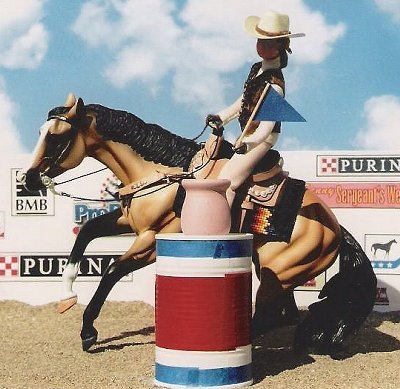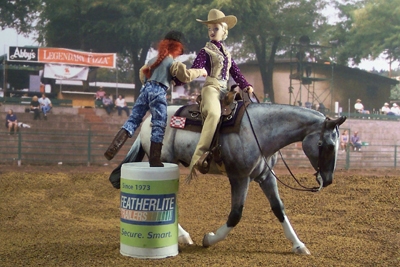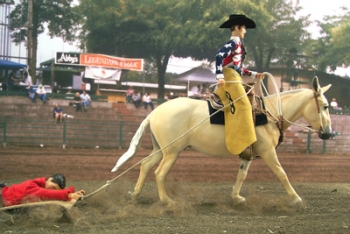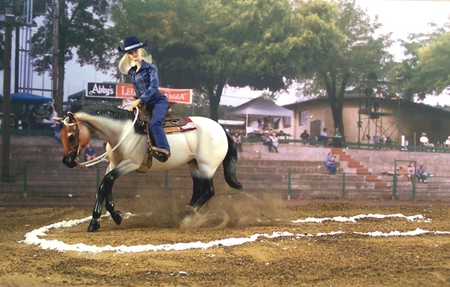IMEHA (International Model Equine Hobbyists Association) was an online photo showing site that existing until 2018. Included on the site were these guidebooks for judging and showing model horses in Performance classes. MEPSA has obtained permission to share the info contained in the guides.
Extra Credit :: Point Deducts :: Tack :: Rider :: Set-Up Options :: Photo Examples
IMEHA Definition of a Speed or Timed Event is when the horse and rider are competing against a clock and are the only entry in the arena during their performance. Or may be a pair of riders racing against each other in heats with the fastest rider advancing to a final heat. Many of the Mounted Games that are popular today are done with Teams. Of course, each member of the team goes at a time, (so only one would appear in the setup) but it is when the entire team completes the event that the team is then timed, fastest team wins.
These are a few examples of Western Other Gymkhana Speed – Timed Games. Meaning the winners with the fastest time normally win. There are many others that you may use. Just be sure to add a comment line with description of the activity and any reference links if you have one.
Apple Bob:
Three styles of this event are note. Rider either rides to where a container of apples are placed in water and then (while mounted) reachs in the container and get a good bite on the apple, retrieves it and ride back to finish while holding apple in their mouth. The other is to dismount and bite the apple and then either remount and ride back or stay grounded and lead back the horse to finish line. Consideration as to age of rider and ability to mount and dismount are taken into consideration.
Balloon Race:
The rider carries several balloons in a cluster that are weighed at the base of the string. Rider tries to drop weighted ballons in the bucket without spooking the horse. Variations of this race is to add obstalce to maneuver such as ground poles or back thru poles. Bucket is typically set up at riders knee height such as a barrel top.
Barrel Crawl:
A timed race to end of arena where rider dismounts and crawls through a barrel remounts and return to finish line.
Beer Can or Soda Can Stack:
Rider races from a starting line to a barrel and stop long enough to place one beer or soda can on the top of an already stacked pile of cans. Rider places a can so that it stays and then turn around the barrel and races back to finish line. Pile of cans are the same number for each entrant to be fair so an attendant must be present to adjust the stack for each entrant.
Boot Race:
A timed Race where boots are piled together at one end of the arena and the entrants ride to the pile from the stating line where the rider dismounts finds their boots, puts them on and leads their horse back to the start. (trick class – the show staff filled your boots with rocks!)
Catalog Race:
The announcer gives each rider a page number. Entrants run to barrel at end of arena, finds page number, tear out and race back with the fastest time and correct page number wins.
Cow Hide Race:
Rider ties a cow hide with lariat to one end, dallies to horn and drags the hide with rider aboard the hide back to the finish line. Usually done in pairs.
Diaper Race:
Team of two riders riding double; in a row of ten riders; run down. One is the ‘baby’ and the other is the mother. Mother puts on the diaper on the ‘baby’ and put on a cloth diaper and both get back on horse. First pair that crosses finish line with diaper correctly on ‘baby’ wins.
Flag Race:
There are two barrels but both at one end of the arena, one is on the left side (with about 15ft or more to the fence) the other on the right (same distance) the flag is in a bucket of sand on one side or the other of the arena. A bucket full of sand but no flag is on the opposite barrel. The point is to run (or walk) down the arena pick up the flag on your way by, put it into the empty bucket and run (or walk) back to the line. There are time penalties for missed buckets or knocked over barrels.
Fox and Hound:
A cloverleaf style barrel race but with two riders and two horses. The first horse leads and the second horse follows. Disqualification if second horse passes before the front of cinch before the first horse finishes the course.
Hat Race:
In theory as boot race but using hats instread of boots.
Izzy Dizzy:
Run down to a bat do 15 circles with forehead on bat and bat and ground get back on your horse and race back to finish line with fastest time the winner.
Keyhole:
A 20 feet in diameter circle with a 4′ wide x 10′ long neck in drawn in the arena with lime or chalk powder. The starting line is 50 to 100 feet according to arena and or associations from the entrance of the keyhole. Time starts as contestant crosses the starting line and runs to through entrance of keyhole, stopping within the confines of the circle. They may turn right or left in the circle. Return to the entrance of the keyhole and run through it and back to finish line. Sets of markers are used at both start and finish lines and the horse must pass between both markers in order of their time to be valid.
Musical Stalls:
Ground poles are laid out in connecting stall fashion. Horse and rider must be in a ‘stall’ when the music goes off. Ground poles are removed per stall for each go around until there is only one winner left. This is a speed game because it is won by hurrying to be the first to get into the last remaining stall.
Nez Perce Stake Race:
Similar to pole bending but horses compete in pairs and in heats until a winner is chosen. The course is done in a mirror fashion with a common finish line.
Pickup & Ride or Rescue Race:
A timed race to end of arena, around a barrel pickup a rider and return.
Relay Races:
Riders entered divide into two teams. Each team as a crop or some item to use as a ‘handoff’. Riders race a course made of manevuers such as serpentines, quarter turns, half turns, etc. The riders ride through the course away from their team and then canter back (without going through course a second time unless you may want to call for running the course backwards which is really funny to watch).
Relay Obstacle Races:
Same type of course as listed above in Relay Race but ostacles that can be cantered over such as those seen in trail class are added. Riders entered divide into two teams. Each team as a crop or some item to use as a ‘handoff’. Riders race a course made of manevuers over the obstacles. The riders ride through the course away from their team and then canter back (without going through course a second time unless you may want to call for running the course backwards which is really funny to watch).
Rope Challenge:
Four foot long ropes are loosely tied to a wire line or a lariat and strung across the arena about 2 feet higher than an average rider’s head while mounted on horseback. Heats are suggested to have no more than 8 horses but not a requirement. When the buzzer or music goes off the riders ride from a starting line to the other end of arena where the ropes are dangling. Each rider tries to grab for a dangling rope and hang on. After each run one rope is taken away or thrown over top of the overhead rope so as to no longer dangle. Heats are conducted like musical chairs in which for example if there are 8 horses 7 ropes are tied until there is only one final rope. This game is a speed game because it is won by hurrying to be the first to grab onto the final rope.
Sack Race:
Two riders dismount and putting one leg in a large feed or gunny sack they race while leading their horses down to a finish line. A variation is when after reaching the line at one when of arena the team mount (usually each other’s horses) and race back to other end of arena to a finish line.
Saddle Race:
A timed race where all the entrant’s saddles and saddle pads are piled in a line and the rider rides bareback from a starting line to where the saddles are lined up. They then dismount, saddle the horse and ride back to finish line.
Steer Daubing:
Rider uses a “lance” to mark the steer within a circle painted on the steer’s side. The circles are painted on both sides of a steer and are 16 to 20 inches in diameter. The lance is approximately 6′ long and is padded at one end and soaked in a washable paint or white wash. The horse and rider are placed behind a barrier, usually the calf roping chute and a steer is releashed at the rider’s signal. The rider has a 1 minute time limit after steer breaks the barrier to prevent needless chasing of the steer.
Stump Race:
Cloverleaf style barrel race with twin course and two horses competing against each other. The course is done in a mirror fashion with a common finish line. Course is larger than normal cloverleaf barrels with front barrel 30 feet from finish line, barrels 75 feet apart and back barrel 94 feet from finish line. First horse from the competing pair to cross finish line wins the heat and goes on to compete in subsequence heats until a final winner is chosen.
Wash Day Races:
Run or ride to the other end of the arena where a clothes line is set up with over lots of different sized shirts/pants. Rider puts on a set of a shirt or pants, blouse or skirt and races back. So funny to watch in real life. Most shows get the clothes from goodwill for free.
Extra Credit Should Be Given If:
(1) Roping Reins and not romal or split reins.
(2) Entry Number is shown on saddle blanket or on rider’s back.
(3) A comment line that says where the horse is in the pattern.
(4) Color coordinated rider and equipment.
Points Should be Deducted If…
(1) Rider uses spurs forward of the cinch.
(2) Loss of hat
Required Tack:
A western stock saddle without tapaderos. The saddle can have either squared or rounded skirts. Can be gaming, working or show saddle. Breastplates are optional. A saddle pad resting under all pressure points is recommended but not required equipment. A western style bridle (browband, one ear, two ear, with or without throatlatch) with a curb bit including a curb strap or curb chain. Standard snaffle bit and bosal hackamores are permitted on horses 4 and under (5 and under for Arabians and Appaloosas). Roping rein are typically seen. Split reins can be used and are typically knotted together.
Prohibited Tack:
Tapaderos are prohibited.
Rider:
Attire is jeans, trousers or pants over western boots, long sleeved shirts, (vest, tie and jacket are also permitted) belt through loop, and western hat. Chaps are optional.
Set-Up Options:
Arena Fencing Required (Indoor or Outdoor Arena)
Types of Fencing Allowed:
- Painted or Natural
- Post and Rail
- Post and Plank
- Chain Link
- Solid Plyboard
- Plyboard with Top Rail
- Post with Drape Rope
- Stock Tube Pipe Rail
- Interior Arena Wall
Footing Required:
- Dirt
- Sand
- No grass base
- No rock base
Backboard or Natural Setting (Indoor or Outdoor)
Examples of Western Other Gymkhana Speed – Timed Game:

Photo Credit:
Western Other Gymkhana Speed – Timed Game
Double M Major Motion shown as a Buckskin QH Gelding. Mold is a CM Creata Gold Standard Jacody by Wilgus. Shown by Andrea Robbins with comment line: Rider deposits flag into container during the timed flag race, while her well-trained horse races past the container.

Photo Credit:
Western Other Gymkhana Speed – Timed Game
Simplee The Last shown as a Dark brown varnish Appaloosa Sporthorse gelding and is a Hot Chic cm’ed and painted by Sherry Clayton. shown by Robin Nere is the Rescue Race with a comment line that reads: Rescue race – having run from start to the barrel, rider now slows to allow the “rescuee” to jump on safely. Junior competitors must wear helmets for safety.


